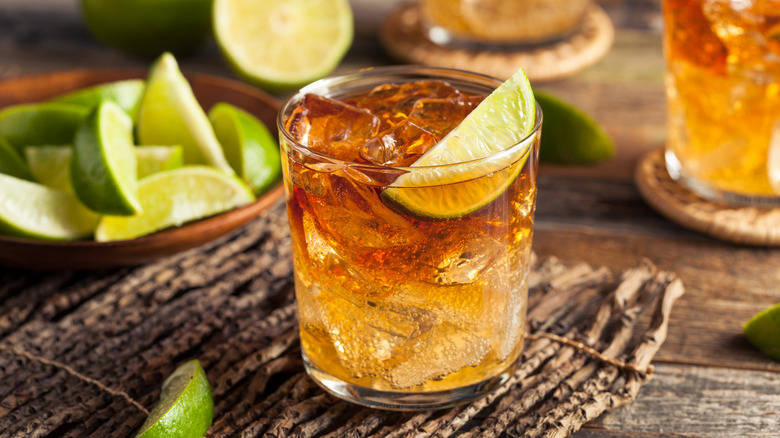The Overlooked Mexican Rum Is Finally Entering The Limelight
Though it may seem impossible, the Mexican spirit mezcal was all but absent from the American cultural memory as little as a few years ago. But around 2020, suddenly the agave-based spirit had a meteoric rise in popularity. For decades, our understanding of Mexican spirits was limited to the familiar (and rightfully beloved) tequila, usually splashed into a margarita. Tequila is also an agave-based liquor but generally carries a lighter, less pronounced flavor profile to the peaty mezcal. Now, mezcal is ubiquitous amongst cocktail enthusiasts, and you can often find at least 1 or 2 mezcal drinks on the menu at a cocktail bar.
But Mexico's distilling industry does not stop at the agave plant. In fact, Mexico is home to a centuries-old rum trade, that is finally entering the mainstream spirits world. Here's what to know about Mexican rum, and what to look out for at the liquor store.
The origins of rum in Mexico
While rum and sugarcane are typically associated with the Caribbean islands, they are the result of colonization, specifically from Spanish colonizers who brought the crops to the islands in the 1500s, according to The Smithsonian. But they didn't stop there, and after conquering Mexico, the Spanish brought sugarcane to the hot, coastal regions of Mexico, such as Veracruz and Oaxaca. In an interview with Punch, Mexican rum distiller Elisandro Gonzalez relays that the sugarcane was used to create panela and rum, referred to as aguardiente de caña, which roughly translates to "cane brandy."
So if Mexico started distilling rum nearly as soon as it started farming sugarcane crops, why haven't you seen this spirit in your local liquor store aisles? Perhaps at least in part because there is a greater demand for culturally authentic dining and drinking experiences. Folks want to understand Mexican food and drinks beyond taco Tuesday and margarita mix, which means looking to many regions of Mexico and gaining a better understanding of their diverse agricultures.
What does Mexican rum taste like?
According to Punch, there are two major types of Mexican rum, aguardiente de caña and Charanda, though of course there are more, less established styles. But these two camps don't mirror the basic distinctions between white and dark rum, so it's important to know what you're looking for on the shelves. The two varieties differ in their distillation ingredients and process. Charanda is made with molasses or fresh-pressed sugar cane juice, but is specific to the Michoacán state. This tends to give Charanda more predictable flavor profiles because the soil and growing conditions are similar across the region. Similarly, this variety has more consistency because less regulated rum makers from other regions can't sell their goods as Charanda.
On the other hand, aguardiente de caña follows far less rigorous specifications. While it also uses fresh-pressed sugarcane juice, aguardiente distillation process is similar to that of rhum agricole blanc, which cuts down on the fermentation period. As a result, the terroir of the spirit is more obvious, meaning that the more raw flavors of the sugarcane and alcohol will shine through, but vary from one soil and sugarcane variety to another. While this may put some consumers off of trying this Mexican rum variety, the prospect of a totally unique drinking experience and flavor profile from bottle to bottle, label to label, is thrilling.


